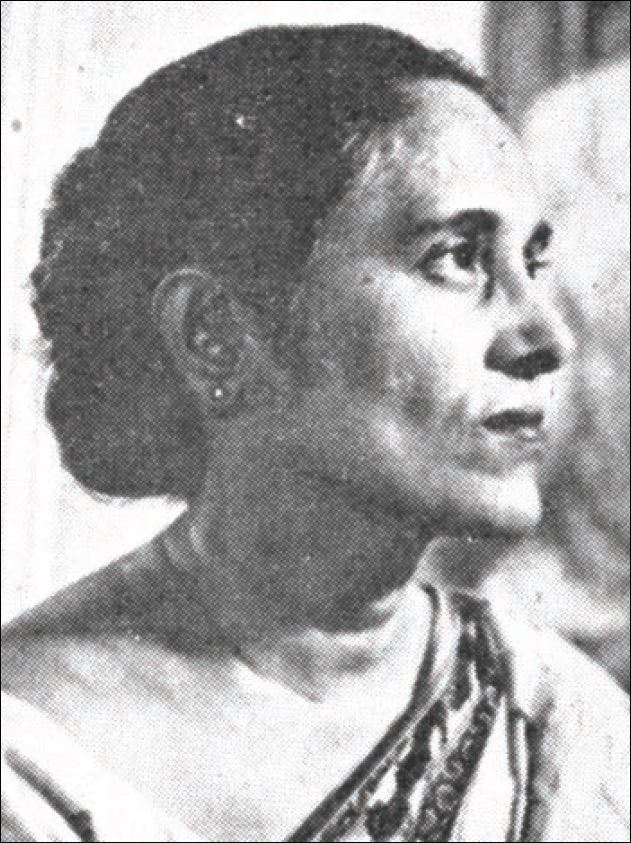In a recently published article in Scroll.in, Kamayani Sharma unveils the remarkable life and artistry of ngela Trindade, an Indian painter celebrated for her Western-style portraits and ground-breaking Christian paintings infused with the essence of Indian aesthetics. Sharma, who was the Kalpalata Fellow for Visual Culture 2022 at Scroll.in and is now part of Sharjah Art Foundation, provides a deep dive into Trindade’s journey, emphasising her trailblazing achievements and the challenges she faced in gaining the recognition she deserves.
Born on August 10, 1909, in Bombay, ngela Trindade was a pivotal figure in Indian art, known for her versatility that spanned Western-style portraits and Christian paintings in the Indian style, and the development of her unique artistic approach called Trindadism. This style, characterised by the symbolic dimensions of the triangle and the Trinity, allowed Trindade to carve out her individuality as an artist, a facet woven seamlessly into her extensive body of work.
The article begins by highlighting Trindade’s early success at the first All India Women Artists’ Exhibition in 1936, where she clinched the gold medal at the age of 27. This period marked the emergence of professionally trained women artists in South Asia, and Trindade stood out as a beacon of talent. Despite this triumph, the article underscores that her visibility within the art world remained modest, setting the stage for an exploration of the challenges faced by Trindade in her artistic journey.
Fundação Oriente’s commendable efforts in hosting a solo exhibition of her works in 2014 provided a focal point for recognizing Trindade’s contribution to the art world. The exhibition, titled “Lights, Colours and Emotions – An Exhibition of Religious Paintings by Angela Trindade (1909-1980),” presented a comprehensive overview of Trindade’s stylistic evolution, including her pioneering Trindadism.
Trindade’s formative years and her upbringing was in a creative and liberal environment. Born to Goan parents, Florentina Noronha and the renowned artist António Xavier Trindade, ngela grew up in Mahim, with her father serving as a key influence on her early artistic inclinations. Trindade’s enrollment in the Sir J.J. School of Art in Bombay, mirroring her father’s footsteps, marked her as the first woman painter to be granted a fellowship by the institution. Her training encompassed both traditional Indian aesthetics and the Western Academic style of oil painting.
The generation to which Trindade belonged is significant as it marked the decline of colonial powers in the Indian subcontinent and the formation of post-independence India. This backdrop becomes crucial in understanding Trindade’s artistic endeavours and the unique amalgamation of Western and Indian influences in her work.
A pivotal aspect of Trindade’s career was her commitment to decolonizing the representation of Christian themes and Biblical scenes in art. The article delves into her efforts to develop an indigenous visual language, combining Christian figures with Indic religious iconography, a journey that aligned with the broader context of the Indian independence movement.
Trindade’s Madonna series, featuring more than two dozen Madonnas, exemplifies her fusion of Christian and Indic elements, with examples such as “Our Lady of the Lotus” (1941) and “Our Lady of Conception” (1956) showcasing her bold and graphic style. The article highlights the symbolism within her artworks, such as the use of lotuses, mudras, and Indian accoutrements, providing a deeper understanding of Trindade’s unique approach in conveying spiritual narratives.
Acclaimed worldwide for an immensely diverse oeuvre that included portraits, landscapes, everyday scenes, and still life, ngela Trindade is recognized as one of India’s foremost artists to Indianize Christian art. As per an article by Patricia Ann Alvares in the Herald Goa, Trindade was greatly influenced by teachers who propagated revivalism in Indian art, leading her to depict Western religious figures in the Indian style. This reflects ngela’s deep religious urges, with her religious paintings being “the result of an urge to represent Christ and His Mother to my people in India in a style that is common to all.” One notable example of this approach, as per Alvares, is her Indian style illustration of the Hindi translation of the New Testament.
Sharma’s article seamlessly weaves in Trindade’s international recognition, particularly her tours in the United States, where she held exhibitions, delivered lectures, and interacted with fellow artists. The article details her shift towards the philosophy and aesthetic of Tantra in the late 1950s, a period that propelled her artistic interest in spiritual themes towards a non-representational idiom.
Trindade’s later years in the United States, her American citizenship in 1978, and her passing in 1980 while visiting relatives in São Paolo are explored, providing insight into the artist’s personal and professional journey.
Sharma concludes the article by reflecting on Trindade’s legacy, emphasising the need for greater recognition and exhibition of her art. It serves as a poignant call to revisit and celebrate the artistic contributions of a pioneer who, despite challenges, left an indelible mark on the canvas of Indian art. ngela Trindade’s unique synthesis of Western and Indian influences, coupled with her trailblazing Trindadism, positions her as an artist ahead of her time, deserving of a more prominent place in the narrative of Indian art history. Sharma’s meticulous examination of ngela Trindade’s life and work amplifies the urgency of securing her position among the influential figures who shaped the artistic landscape of the nation.

